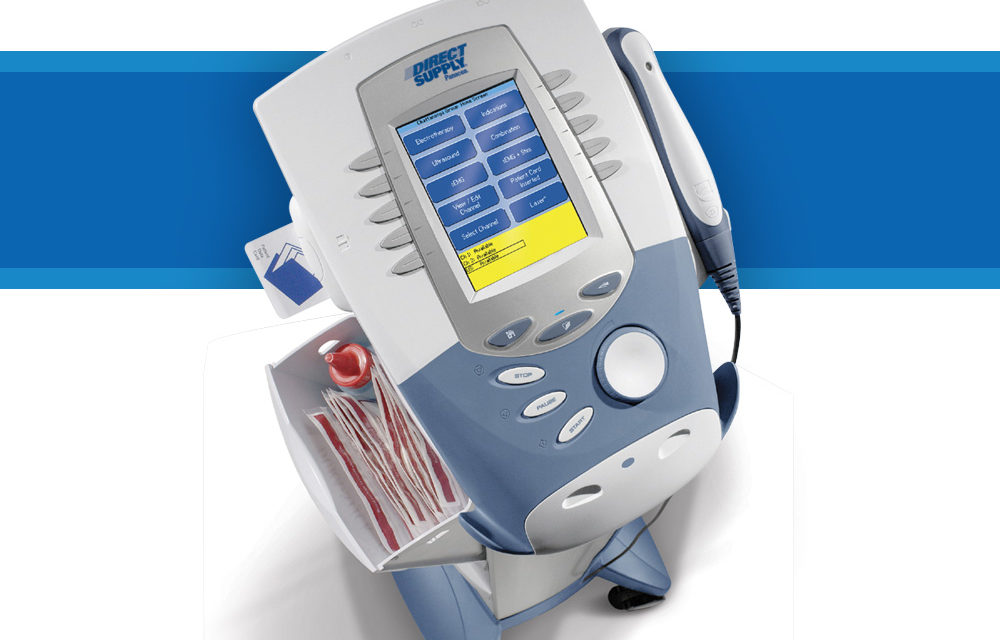Medical Electrical Stimulation Devices for Physical Therapy
The goal of any physical therapy program is to restore your seniors’ bodies to normal, healthy functionality following an injury, accident or lapse in condition. When putting together a treatment plan, you must simultaneously address the symptoms that follow an episode requiring therapy – this includes pain, decreased strength, swelling and a decline in range of motion. While every senior’s unique condition requires an individual plan, a clinical electrical stimulation device is capable of providing relief that can help resolve all of these symptoms.
A clinical electrical stimulation (CES) device converts electricity into a specific waveform for therapeutic delivery. These distinct currents encourage muscle contraction that leads to strengthening, pain reduction, and a vital increase in blood circulation. Integrating electric stimulation therapy into your rehabilitation department can aid your staff in preventing atrophy while providing the optimal therapy equipment for your seniors. As you begin to search for the perfect CES for your healthcare setting, you’ll quickly discover the hundreds of available units on the market today. From TENS to NMES to FES units, we’ve put together this guide to help you find the right electric therapy equipment for your unique healthcare setting.
Read on to learn how to find the best electrical stimulation device to enhance your healthcare setting’s physical therapy program!
What’s the difference between electric stimulation devices?
CES or electrostimulation devices go by many different names. You’ll see common names, like TENS (Transcutaneous Electrical Nerve Stimulation), NMES (NeuroMuscular Electrical Stimulation) and FES (Functional Electrical Stimulation). These names may be used interchangeably, but each of these devices is designed to have a specific physiological effect on the human body:
TENS – Transcutaneous Electrical Nerve Stimulation units are intended for temporary pain relief in sore and aching muscles or symptomatic relief of chronic or acute pain. TENS devices work by sending a string of electrical pulses across the body’s skin and nerve strands. These units have also shown efficacy in releasing endorphins to aid in pain relief.
NMES – Neuromuscular Electrical Stimulation machines are intended for relaxing muscle spasms, preventing muscle atrophy, increasing blood circulation, maintaining or increasing range of motion, and reeducating the neuromuscular system. The best NMES units aid in physical therapy by being used to strengthen and retrain muscle functions after a surgery or lack of use. Neuromuscular Stimulation units can also aid therapists in treating dysphagia. Find the best NMES devices for dysphagia, muscle relaxation, NMES physical therapy and more!

FES – Functional Electrical Stimulation units offer similar benefits to NMES. When comparing NMES vs FES, FES therapy specifically aids in neurological rehabilitation as the stimulation is automatically controlled to turn muscle contractions into functional movements.
A FES electric therapy machine device generates body movements for those who may be paralyzed due to Central Nervous System complications.
It is important to carefully examine the exact functionality of a unit you intend to buy, ensuring it fits with your healthcare setting’s care plan – not all CES devices are created equal!
How many waveforms for electrical stimulation devices?
Electrical stimulation therapy machines have various waveforms that affect different aspects of the body and musculature. Therefore, having a CES device that features multiple waveforms and intensity levels is essential to fully addressing the needs of your healthcare setting. When seeking out the best electrical stimulator, make sure that the device has at least the following waveforms:
Medium Frequency: Interferential current and/or premodulation – used to address pain
Asymmetrical Biphasic: TENS/NMES – used for stimulation of the nerve fibers and muscles
Symmetrical Waveform: VMS – used for muscle strengthening
Monophasic Waveform: High-voltage pulsed current and microcurrent – used to increase circulation in the tissue
Electrical Stimulation Devices FAQ:
What are the different types of electrical stimulation units?
The different types of electrostimulation devices include TENS (Transcutaneous Electrical Nerve Stimulation), NMES (Neuromuscular Electrical Stimulation) and FES (Functional Electrical Stimulation).
How do you use an electrical stimulation machine for patient therapy?
A clinical electrical stimulation (CES) device converts electricity into a specific waveform for therapeutic delivery. These distinct currents encourage muscle contraction that leads to strengthening, pain reduction, and a vital increase in blood circulation.
What are the different electrical stimulation waveforms?
There are four different types of electrical stimulation waveforms: medium frequency, symmetrical, asymmetrical, and monophasic.
What else should I ask when choosing the best electrical stimulation device?
Once you have a broad idea of the best electrical stimulation unit for your healthcare setting, the next step is to gain as much information as you can to ensure the device integrates seamlessly into your healthcare setting. If you plan on purchasing a CES device from Direct Supply, contact us for specific answers to these questions and more:
• What waveforms does the device have in it?
• Can you use multiple waveforms at the same time?
• Who will teach my therapist how to use the device?
• What is the warranty on the device?
• Who do my therapists call with questions?
• Can my therapist try the device for a couple of weeks to see how it fits their practice?
• Can you provide references of other facilities using your device?
Find the best physical therapy electrical stimulation device today!
Your most important goal is the well-being of your residents – ensuring your therapists have the right equipment on hand will help support the best clinical outcomes for muscle recovery and physical therapy. Direct Supply has the products, resources and expertise to help you with all steps of a new CES device integration. Contact us today!
Want to find out if owning your modality is the right investment?




